

|
|||||||||||||||
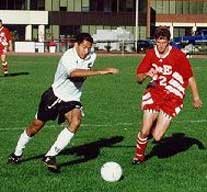 |
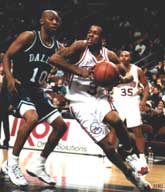 |
FIGURE 3 - Activities that involve full-speed running, jumping, cutting and pivoting are "high risk" for someone with a torn or loose ACL. Treating such high-demand athletes by rehabilitation and knee bracing alone has a fairly high failure rate. |
In general, approximately one-third of individuals who tear their ACL will do rather well without any form of surgery to repair or rebuild it; another third will experience difficulties that may involve limited re-injury and/or an unwanted decrease in activity level, and the remaining third will do poorly if surgery is not performed, re-injuring their knee time after time and often causing irreparable cartilage loss. While many individuals (usually those in the first 1/3 referenced above) possess excellent natural compensatory mechanisms which reduce or eliminate recurrent subluxation injuries, individuals at the opposite end of the spectrum often cannot even perform their routine activities of daily living safely without a functioning ACL in their knee! As of yet, no method exists to accurately differentiate and identify with certainty the "good compensators" vs. the "bad compensators", in advance. Only "trial by fire" (i.e., a return to physical activity without surgical reconstruction of the ligament) allows this determination to be made. However, the medical decision-making process with regard to the choice of treatment is by no means totally blind.
Perhaps the most important predictive factor that assists in this decision-making process is an assessment of the specific physical demands that are likely to be placed upon the patient's knee in the future. If high-performance athletic activity that involves running, jumping, cutting and pivoting is realistically on your future activity list, the odds of your knee suffering recurrent injury (even with appropriate knee brace treatment) are reasonably high and thus, surgical reconstruction of the ACL should seriously be considered. On the other hand, if activities such as cycling, rowing, straight-ahead jogging on level surfaces, or aerobic fitness work on exercise machines (see FIGURE 4) are going to be the most strenuous way in which your knee will be used, conservative (non-operative) treatment by way of a comprehensive program of rehabilitation and knee bracing may work very well and thus save you considerable time, effort, and expense.
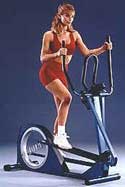 |
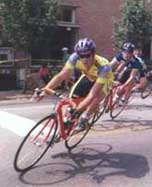 |
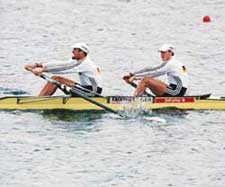 |
| FIGURE 4 - There are many physical activities that pose little or no risk to an individual with a torn or loose ACL, such as using fitness exercise machines, cycling and rowing. | ||
Another factor that enters into the decision-making process is exactly how unstable your injured knee joint is, both functionally (how frequently and easily it "gives out" on you) and structurally (how much measurable joint looseness it has). All knees do not depend equally upon the anterior cruciate ligament for maintenance of proper mechanical joint function. Some knees are more "cruciate dependent" than others. For example, a person with a relatively non-cruciate dependent knee might never even appreciate or feel the difference between the knee's condition before vs. after his or her anterior cruciate ligament was torn, once the initial pain from the tear itself has subsided. On the other hand, someone who possesses a very cruciate-dependent knee may have difficulty performing even routine daily activities without having their knee give out on them, after tearing their ACL. The physical examination provided by an experienced knee surgeon can rate or grade the degree of structural joint laxity or instability that you have, thus providing another piece of data to be entered into the overall decision-making equation. In general, a low-grade instability combined with a low-demand physical activity requirement represents a situation that is often best handled by non-operative means, whereas the opposite would be the case for a high-grade instability in the face of a high-demand physical activity requirement.
 |
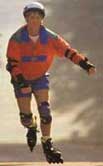 |
| FIGURE 5 - Skiing, skating and roller-blading represent "in between" risk activities for someone with a torn or loose ACL. Treatment with bracing alone may or may not suffice, depending on a host of factors including how strong your leg muscles are and how extreme your participation level is. Remember, even a totally healthy ACL will not necessarily prevent a knee injury if you take a fall. | |
If you are in an in-between or "middle of the road" situation (see FIGURE 5), another factor worth considering relates to the timing of surgical treatment. Anterior cruciate ligament tears that are reconstructed fairly early on following injury (within the first six to twelve weeks or so) tend to achieve a slightly more stable and successful result with surgery than those knees that have been loose a long time and whose secondary ligamentous constraints (remaining knee ligaments) have been stretched out by recurrent giving-way episodes. Several surgical researchers have observed that an anterior cruciate ligament injury that is treated sooner rather than later has perhaps a 5% to 10% better prognosis for a successful surgical restoration of ligament stability than an anterior cruciate ligament injury that is treated in a delayed fashion, after the instability condition has been allowed to become chronic. For someone who is in a situation where both non-operative treatment and operative treatment would appear to be reasonable, this slightly different prognosis for the results of acute (early) versus chronic (late) surgical treatment may become the "tie breaker" that leads the patient to opt for surgical management at the outset.
An additional factor that must be weighed in the decision-making process is the status of the various other knee joint structures. When other knee ligaments are torn along with the ACL it may be more desirable to rebuild the ACL than otherwise. The presence of surgically repairable knee cartilage (meniscus) tears also favors ACL reconstruction because repaired menisci generally heal better and last longer when the ACL is fixed at the same time.
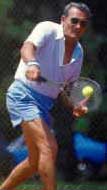 |
FIGURE 6 - A patient's age may be of little importance in deciding whether or not to have a torn ACL rebuilt. A physically active, 55-year-old may benefit more from ACL reconstruction than a sedentary 20-year-old! |
Interestingly enough, age by itself is of little
importance in deciding whether or not to have a torn anterior
cruciate ligament reconstructed. All other things being equal
(i.e., similar activity level and grade of knee instability),
a patient between 40 and 60 may be just as good a candidate
for surgery as someone in their twenties. A patient's age,
however, may affect the particular surgical technique that is
best suited for them.